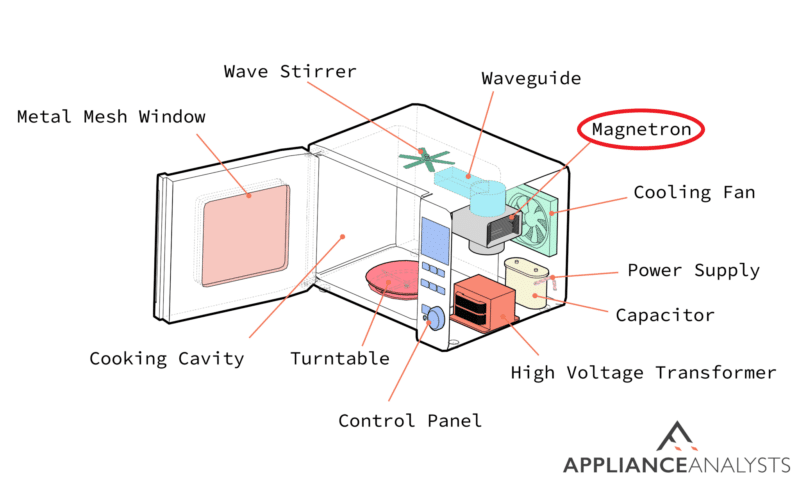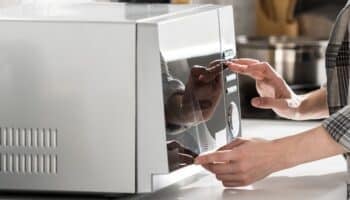Is your microwave getting hot, even when not in use?
If so, I know it can be a frustrating experience. You’re probably worried that your microwave is overheating, and you might even be wondering whether the overheating poses a safety hazard. But don’t worry; you can address microwave malfunctions in many ways.
Your microwave might get hot when not in use due to many potential causes, such as insufficient breathing space. It could also be that a part inside the microwave is overheating or that you’re putting the wrong kind of food inside its compartment.
Whatever the case, you need to do something about the overheating – pronto. Luckily, I’ve already taken care of all the research for you. Below, you’ll find a list of the potential culprits behind your microwave overheating and simple solutions to each one.
Ready? Let’s dive in!
How Hot Should a Microwave Get?
It’s not unusual for the exterior of a microwave to get warm. After all, microwaves generate a lot of energy to heat/cook your meals.
If you touch your microwave, it should feel warm, but not hot enough that you can’t keep your hand on it for longer than a second or two. In my experience, a microwave surface that’s hot enough to cause burns is a sign of there being something wrong.
Why Does Your Microwave Get Hot, Even When Turned Off?
Microwave overheating is not unheard of, but there are also no cookie-cutter answers to the issue, as there can be several reasons behind it. Here are the most common causes of excess microwave heat.
#1 You Use Your Microwave Too Often
The first possible explanation for why your microwave is hot when not in use is that you use it too often. If your microwave stays in operation continuously for several minutes, it will take a long time to cool off.
Microwaves are not designed to run for long periods but rather for short intervals. If you try to bake a full-sized cake in the appliance for 30 minutes non-stop, the microwave will start to overheat, and it could even trip your circuit breakers.
#2 You Cook Food That Generates a Lot of Steam
Another possible reason why your microwave is overheating is that you’re cooking food that generates a lot of steam.

Steam is naturally hot, and the internal components of the microwave can absorb it.
Excess steam will cause the appliance to take longer to cool down, which can trick you into thinking that your microwave is hot, even while not in use. In cases with abundant steam, I tend to find that waiting a little while and leaving the microwave’s door open helps speed up the cooling process.
#3 The Magnetron Is Overheating
A hot Magnetron could also explain why your microwave is hot when not in use. The Magnetron is the lifeblood of your microwave, as, without it, the appliance can’t heat food.

In a nutshell, the food-heating process inside a microwave occurs when electromagnetic waves cause the water particles in your food to accelerate, thus increasing the overall temperature. The Magnetron plays a key role in the heating process, but sometimes, if it’s failing or overworked, it can overheat and cause a lot of trouble.
Luckily, most microwaves have failsafe mechanisms that immediately shut the appliance off when the heat reaches dangerous levels. However, using a microwave with a bad Magnetron can be risky over time, so when I see the component fail, I always recommend calling a professional to check it.
Magnetrons are no joke. Professional technicians have to undergo long training and pass safety certifications to work on Magnetrons, so please, DO NOT try to repair or replace the component on your own.
#4 The Microwave Is Staying On Inappropriately
Assuming your microwave is still overheating, there’s also the possibility that the control board is faulty, and it’s keeping one or many buttons pressed, causing the appliance to keep running while not in use.
Control board issues are common and, luckily, quite easy to fix.
Sometimes, all a control board needs is a deep-cleaning session. And even when the component needs more than cleaning, replacing the control board is also relatively simple – here’s what you have to do:
- Unplug your microwave from the wall outlet.
- Remove the side vent inside the microwave (on the side where the control board is).
- Undo the screw holding the control board in place (From what I’ve seen, typically, there’s only one).
- Install the new control board and membrane and reassemble the microwave. You can normally find a replacement control board and membrane for anywhere between $80-$150.
If you want to get any replacement part – or see how much one would cost – click to enter your model number in the search bar below. Our partners at AppliancePartsPros stock almost every part with free guides on how to install them.

You might be better off buying another one altogether depending on how much you paid for your microwave. In my opinion, unless you own a high-end microwave, the cost of repairs should never exceed 50% of a brand-new replacement unit.
#5 There Is Not Enough Space
The last possible reason your microwave is hot when not in use is that there’s not enough breathing room for it to cool down properly.

As with many other heat-generating appliances, microwaves need a certain amount of space between the unit’s body and the surrounding walls.
You’re probably asking yourself, “What about wall-mounted microwaves, then? Those have no breathing room” – and that’s a valid point!
The thing is that most microwaves are designed to prevent overheating under proper use. Even if there’s not enough breathing room for them, microwaves will keep a stable temperature throughout the day when used for short periods.
So, giving your microwave enough breathing room is not always mandatory, but it can help make the cooling down process much faster.
Conclusion
That about covers it!
When your microwave gets hot when not in use, you can quickly become worried that the appliance might explode.
Luckily, as I hope this piece has helped you better understand, the most common causes behind microwave overheating can be addressed easily and quickly. More often than not, something simple like replacing the control board and letting the microwave cool down will do the trick.
Thank you very much for sticking with me all the way to the end. If this article piqued your interest and answered your questions, please check out our other incredible resources below and consider subscribing to our newsletter.
Happy cooking!
-Craig.








